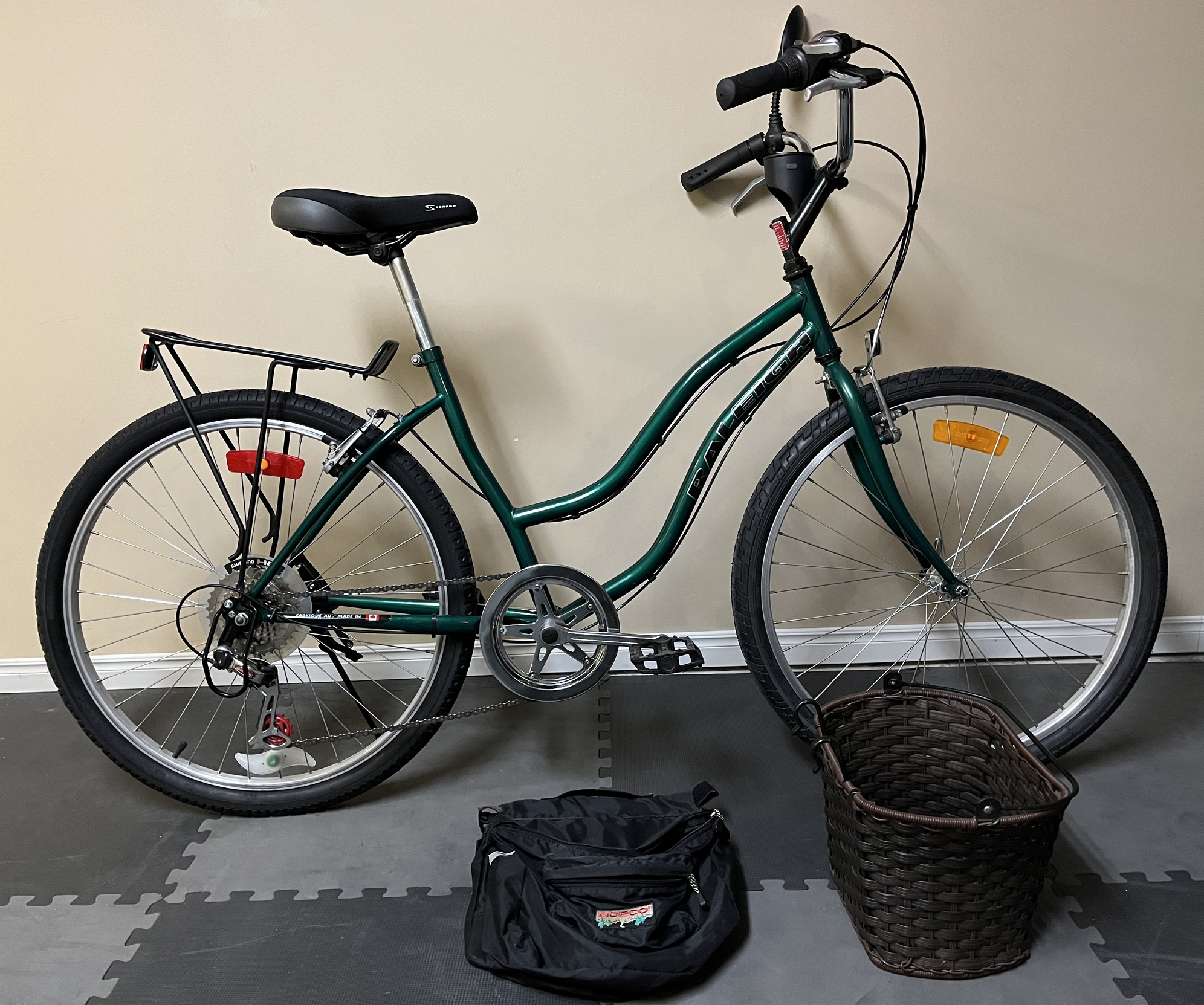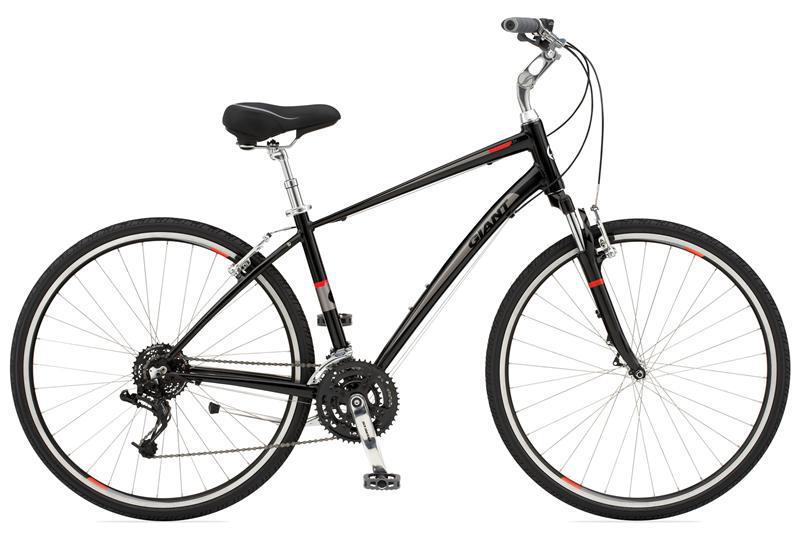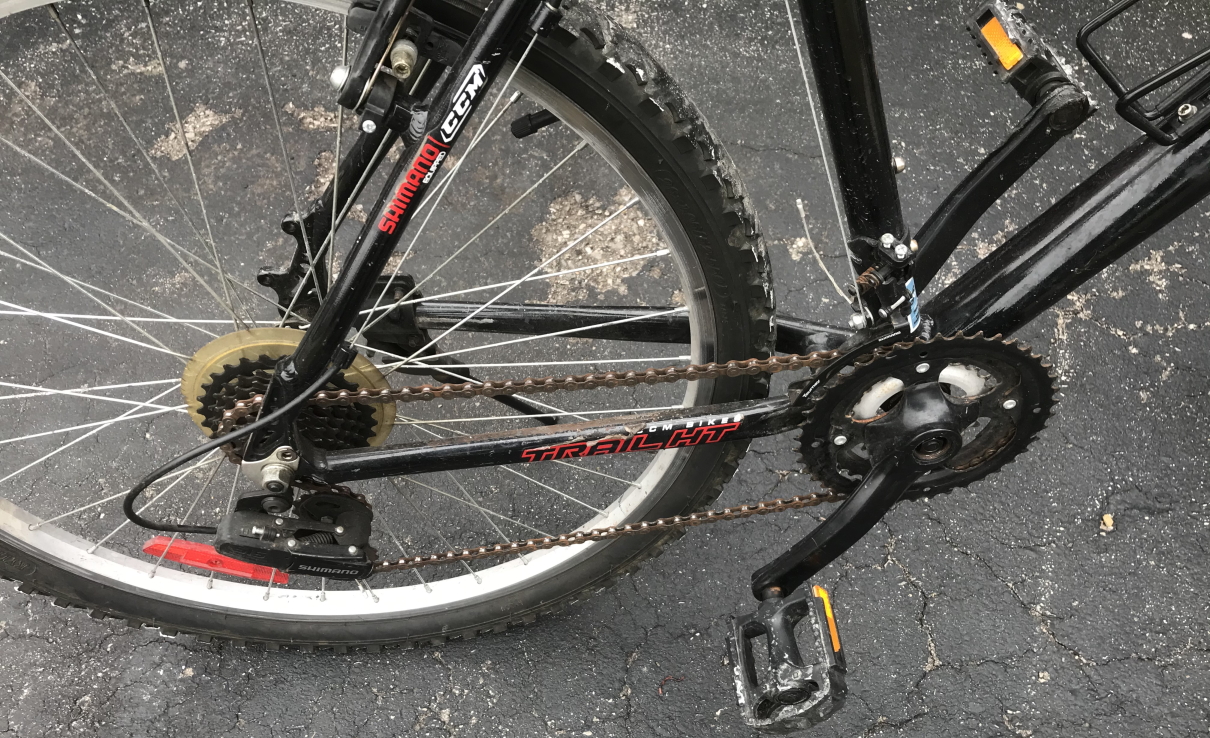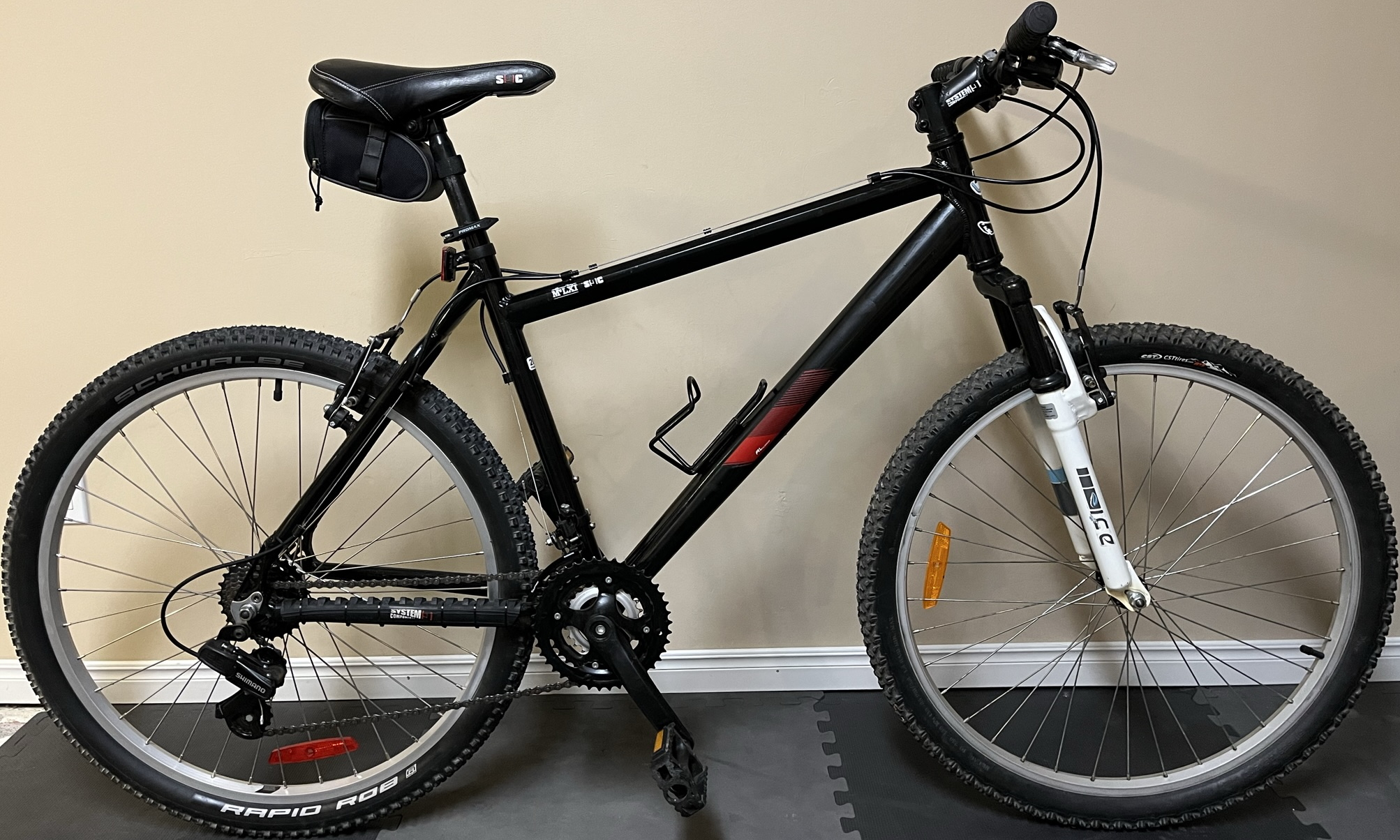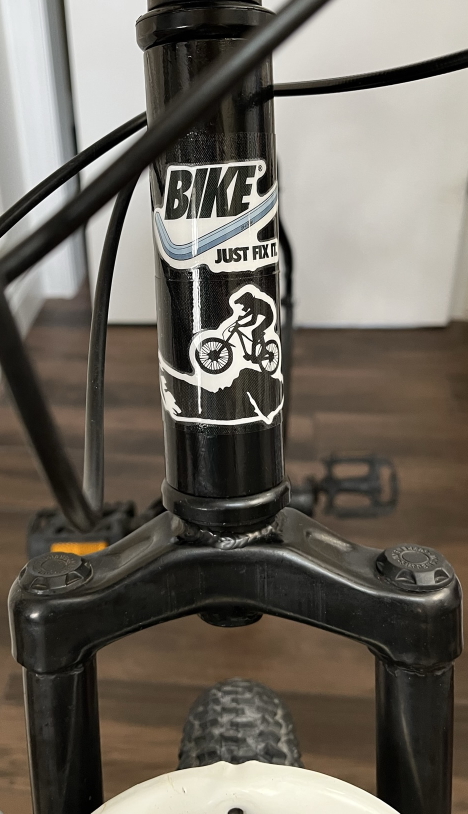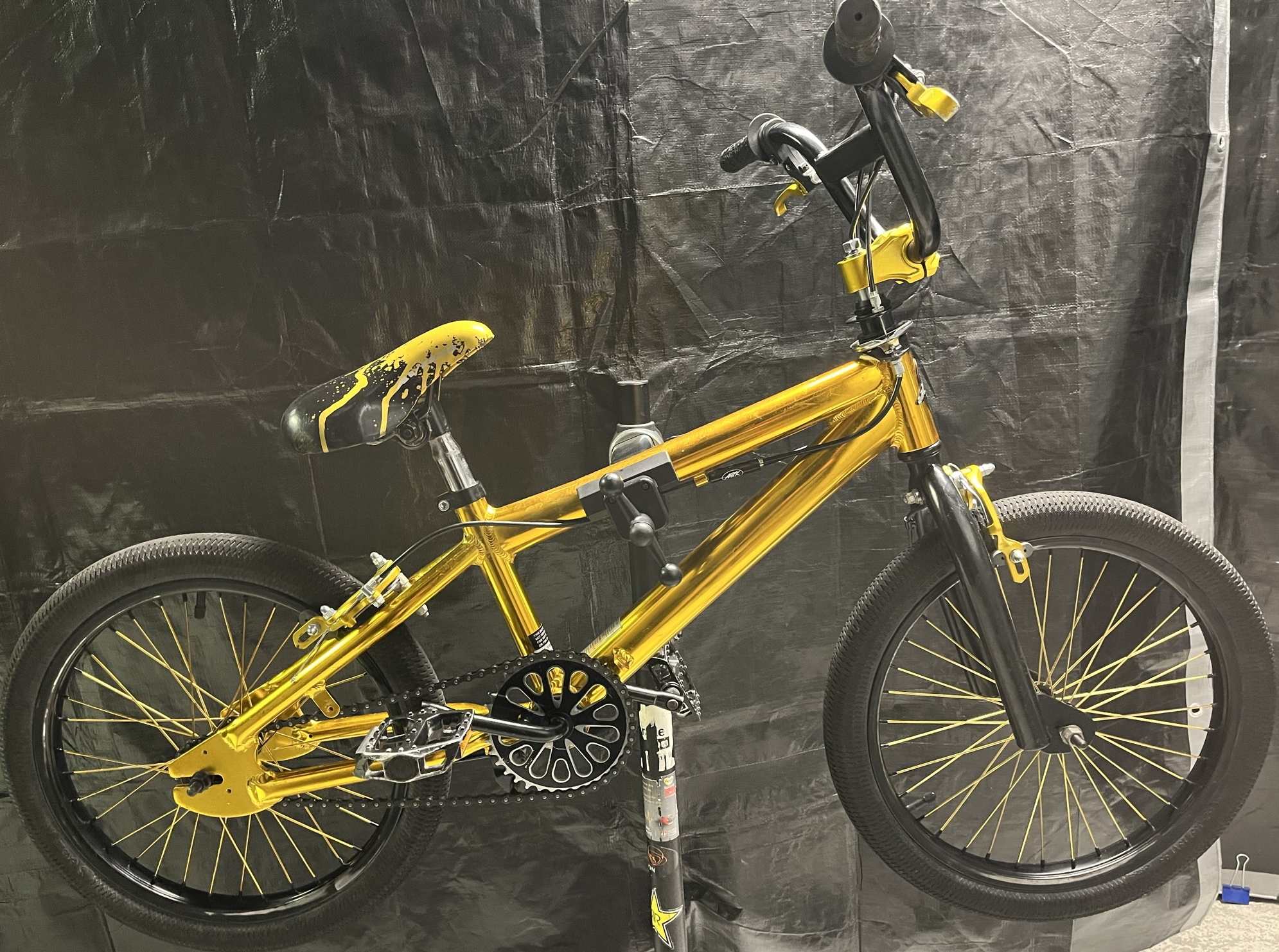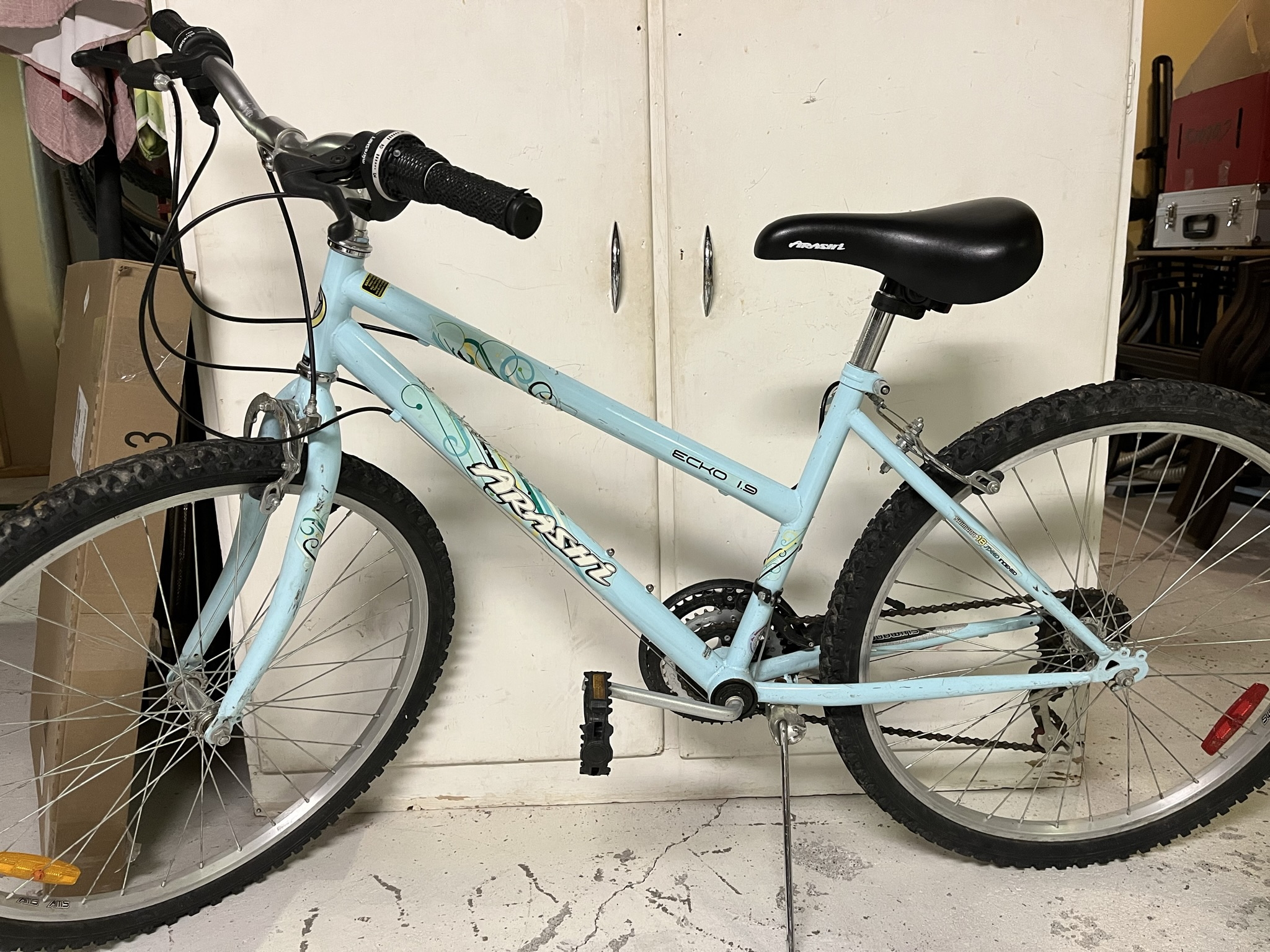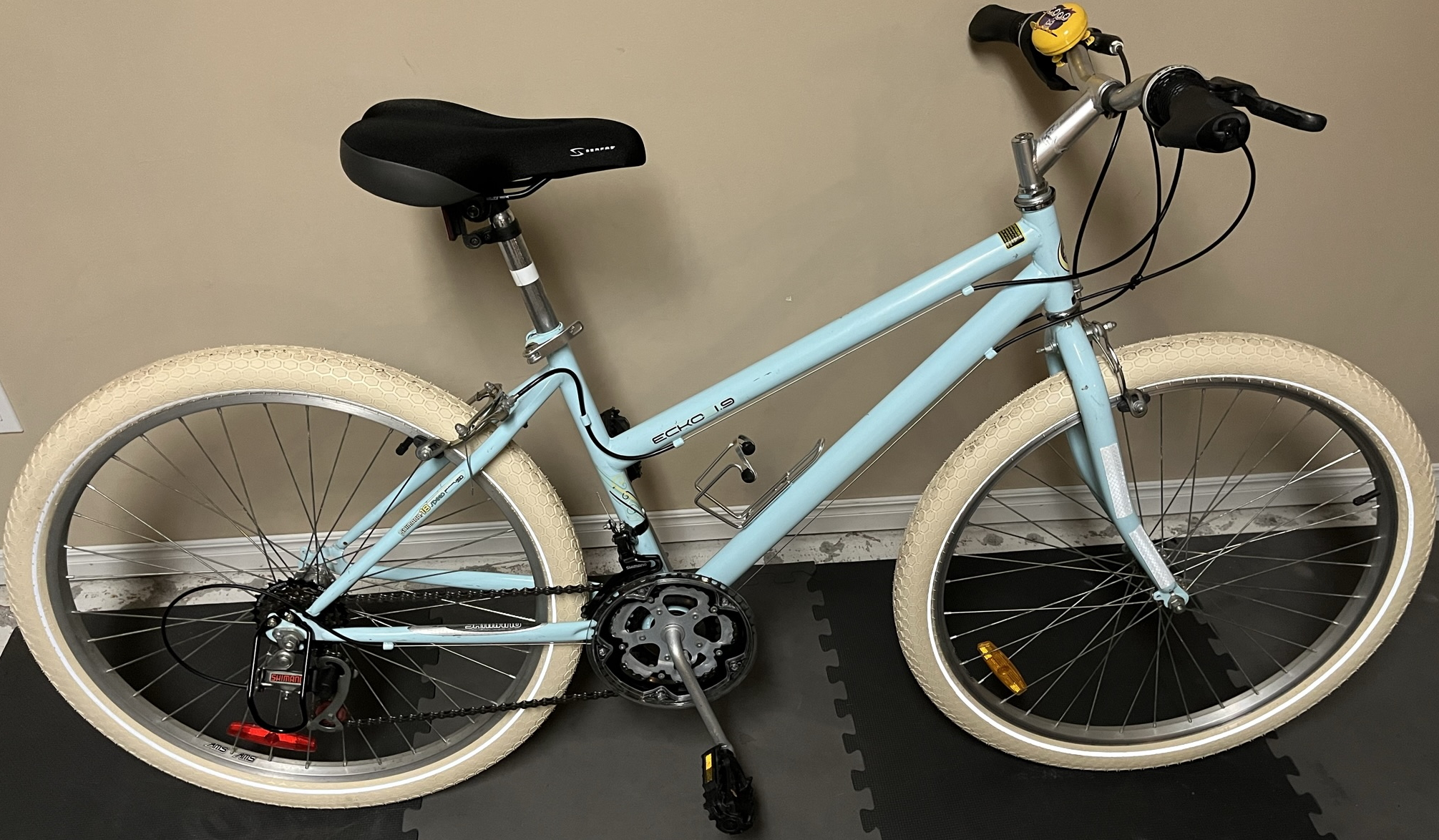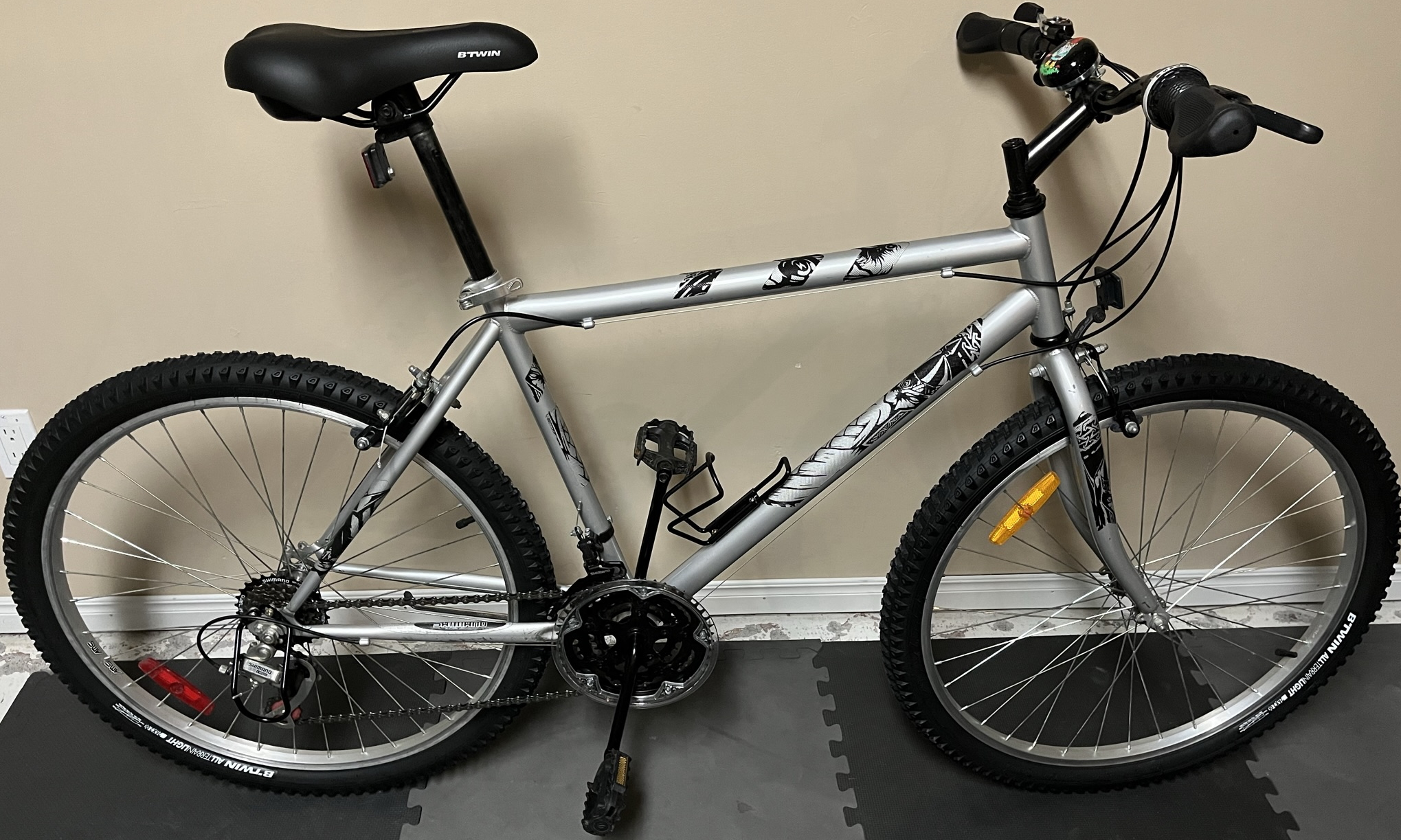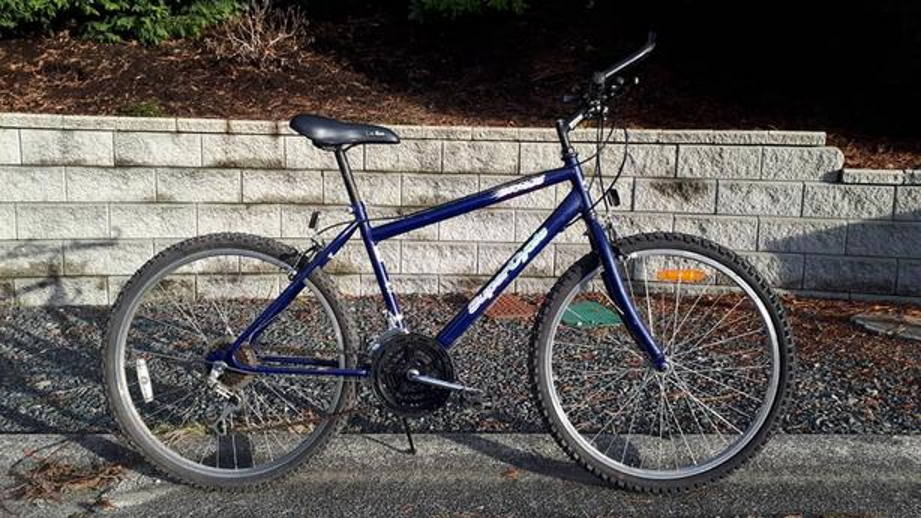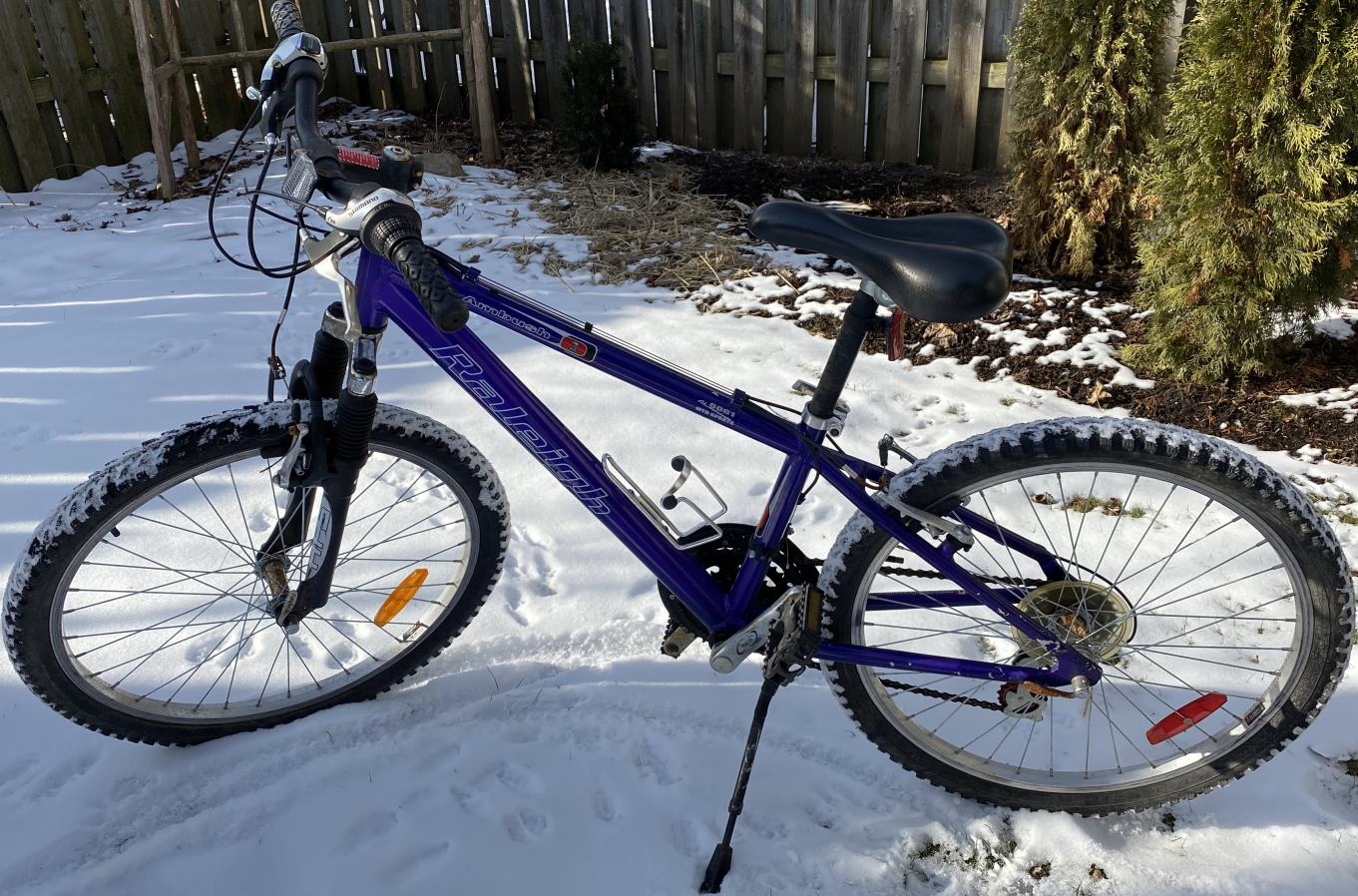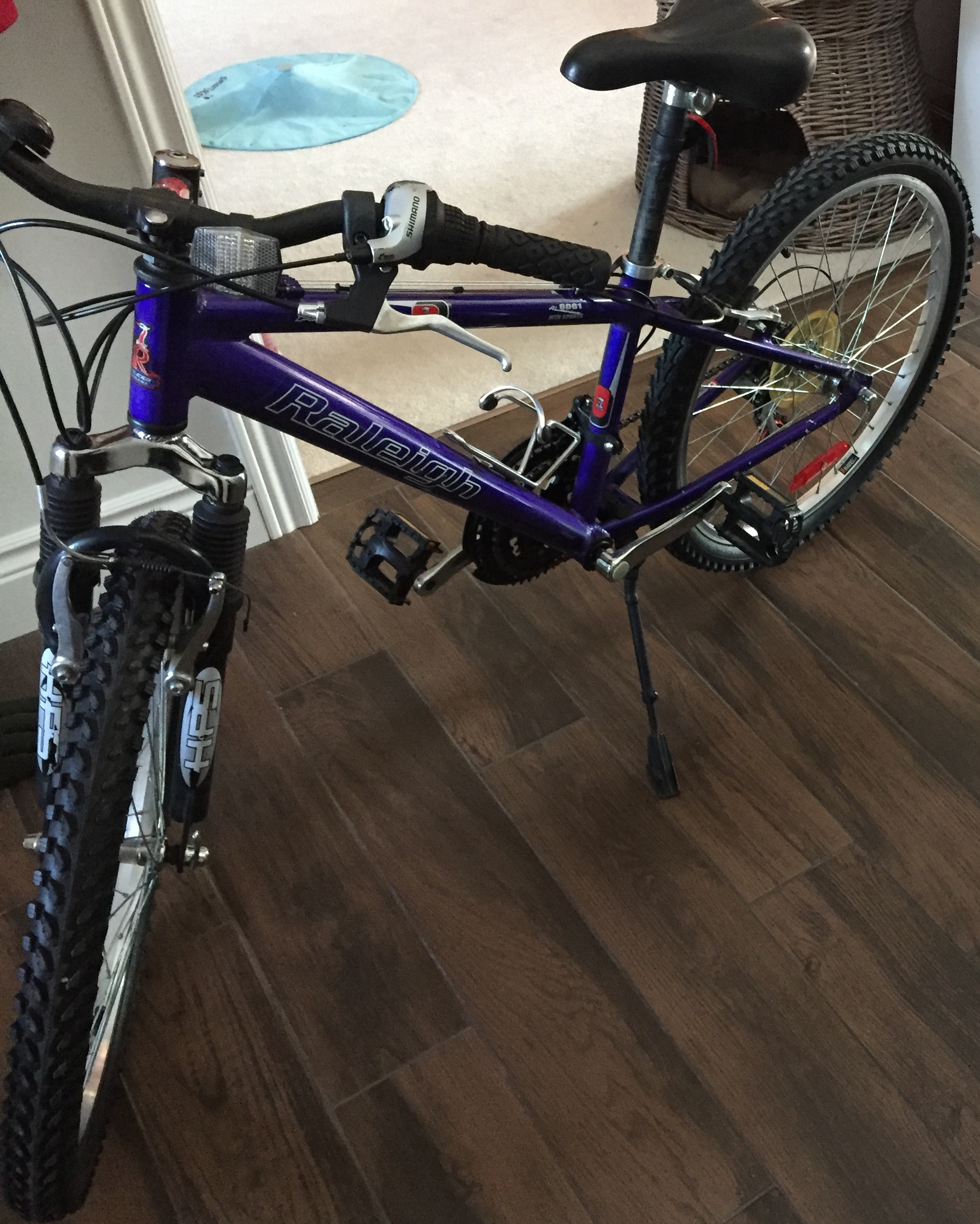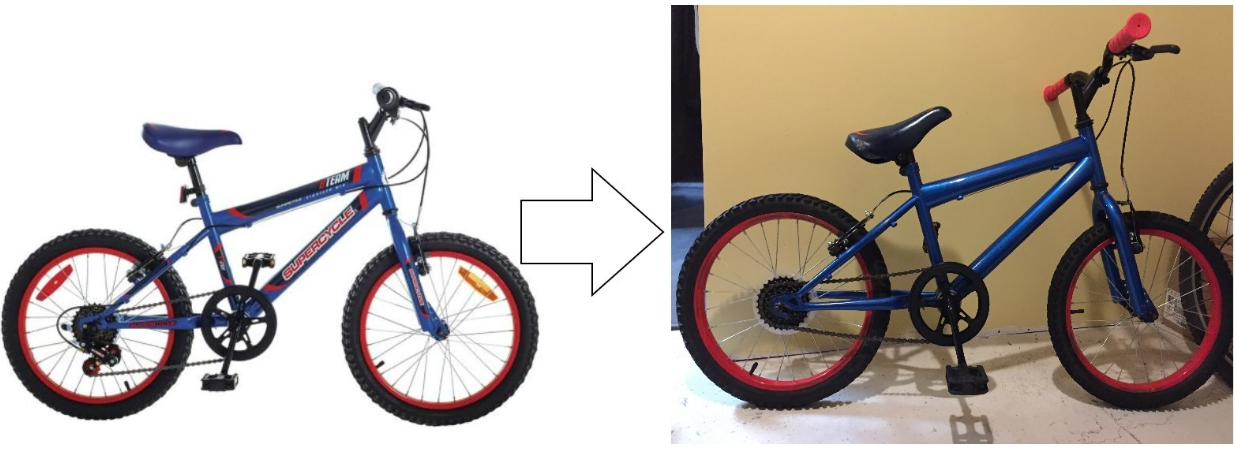Bicycle Repair Portfolio
Here is a listing of the different bicycles I (Uncle Erik) have repaired for my family and in-laws over the years and have learned a lot from.
This list will get updated from time to time as more bicycles are fixed.
BEFORE RESTORATION:
My wife's aunt was looking for a step-through bicycle that would fit her (she is 5'1" (155cm)) and her inseam measurement is 28 inches (71cm). She had a budget of CAD500. She was not in a rush to get a bike so I took my time seeing if anything came up that might work for her.
I found decent step-through bikes (not today's department store bikes) within that price range but they were sporting 700c wheels and were sized for taller people.
After looking at Kijiji (Canadian classified (buy/sell/trade) site), I found a listing for CAD50 for a Raleigh step-through bike that has seen better days and looked like it was from the 1990's, but featured a rear rack and several accessories. The pictures on the listing were low-resolution and did not showcase the bike very well. Raleigh in Canada has become a department store brand for a while (it was not always that way, having a rich history in England since 1887 and having been the world's biggest bicycle maker at one time), but from 1973 to 2013 they were still building the bikes in Canada for the Canadian market. I considered the colour quite dated, but my wife's aunt did not seem to mind and called it "retro". The bike sported 26" wheels, so I had high hopes it would fit her. The accessories being included lessened my worries, so I went to see the bike for myself. The "Made in Canada" sticker on the chainstay was a good sign that it was built during a time (and place) where/when people actually cared about quality. The bicycle was mechanically sound but looked like it was sitting in a garage for the better part of 30 years. This was the seller's wife's bike, and she is 5 feet 0 inches tall. The seatpost also went down to the desired inseam measurement (from the top of the seat to the lowest position of the pedal).
Despite the following (see list below), I was confident in the bike's restoration (I was going to charge my wife's aunt only for parts, knowing that I can work on the bike over several months, learn from the procedure, and it would make for a nice 60th birthday present from my wife and I) so I took it home.
SYMPTOMS:
- Pedals don't spin as well as they should (pedals do not seem original to the bike).
- Tires are dry-rotted.
- Surface rust on chrome parts.
- Some issues with shifting gears.
- Rear brakes do not work properly.
- Handlebar grips have deteriorated to the point that they are fused to the handlebar and only pieces come out in flakes.
- Rear rack pannier bag needs a deep cleaning.
- Bell is broken, but it looks like the issue might be fixable.
- Seat has a tear in it.
- Some of the branding stickers are peeling off.
- Drivetrain is sound but needs cleaning.
- At first I thought that the rear rack was not level, but learned later that this is by design. The moves the bottom of the rack panniers at an angle to give the rider more heel clearance so as not to hit the panniers while pedaling.
AFTER RESTORATION:
The following restoration tasks were done:
- Chain has plenty of life left according to chain gauge. Thoroughly cleaned chain, lubed it and it works like new.
- Purchased new 26" tires and installed bike tire puncture protection liners.
- Rust removal and restored shine on cranks, handlebars and chainring protector.
- Restored quill stem fastener.
- Applied transparent protective film on chainstay to preserve the "Made In Canada" bike bling sticker. Removed some peeling stickers for a cleaner look.
- Fixed hole in bike seat. Saved this seat as a spare, because it's from a different era with no ergonomics in mind. I instead purchased a Serfas Tailbones Comfort Saddle with Cut-Out (ergonomic saddle with progressive density foam and channel through the center of the saddle).
- Minor wheel truing.
- Overhauled wheel hubs.
- Overhauled bottom bracket.
- Overhauled headset.
- Overhauled pedal bearings.
- Changed shifter cable and housing.
- Changed brake cable and housing; brake levers were not in correct position.
- Replaced handlebar grips (used the nickel trick to help make the grips last longer), repaired the bell and cleaned the pannier bag.
- Purchased and installed a handlebar-mounted bottle holder.
- Purchased and installed a derailleur guard (this bike does not have a derailleur hanger).
Total cost: CAD276.24 (well below her budget)
BEFORE UPGRADES:
The several-years-ago old picture above was the most recent picture available (of the bike on its own without its rider) before the upgrades (the wired bicycle computer was changed to wireless a while ago and tires have changed from 26x2.0 to 26x2.1). Notice the rim brakes, aluminum seat post, and small saddle bag with parts held by duct tape.
Customer (me) has the following requests:
- Look into an externally-routed, affordable dropper post in order to be able to safely go in some black diamond downhill stretches at his local trail. Do not use a dropper post with its own lever right under the seat (it is a safety hazard); so we have to purchase a lever too.
- Look into new grips that will allow to change position on long rail trail rides but not impact mountain biking ability. Bonus points if they don't make carpal-tunnel affected wrists symptoms worse.
- Replace small saddle bag with parts held by duct tape with something that offers more space but is not too bulky / gets in the way.
- Upgrade to mechanical disc brakes; the frame/fork/hubs are all disc-ready with the appropriate mounting holes (it's a shame the bike did not come with disc brakes to begin with).
- Also fix a slight knock/thump feeling going all the way from the bottom bracket, up the seatpost and to the seat only felt when pedalling at a certain rate.
AFTER UPGRADES:
The following actions were taken:
- Bike has been in use on weekends since 2008, so it's not a bad time to replace the Shimano BB-UN26 LL113 (68, BC1.37x24, 113mm) sealed bottom bracket cartridge.
The modern Shimano-branded replacement bottom bracket cartridge for a 2007 Scott Scale 60 is a BB-UN300 LL113 (English/ISO, Square taper, 113mm length, 68mm width sealed bottom bracket cartridge). - The handlebars are narrow anyway on this twitchy Cross-country (XC) hardtail, so using Ergon GP2 grips should not negatively affect the ride (by getting the bike snagged into vegetation) and provide a secondary hand position for riding long distances along with some hand cushioning. The knockoffs on Amazon have dyes that transfer to your hands/gloves which may or may not be toxic, so it was worth paying a little more for the real Ergon grips. The GS2 might be a little better for XC (a little shorter on the padding) but there was no suitable availability, so the GP2 was chosen.
- After trying several sizes of the Topeak Aero Wedge saddle bag at the local bike shop, the Large size was purchased.
- Several dropper post offerings out there are worth more than the bike. Need to factor in external routing (no holes already in the frame for routing dropper cables) and the saddle bag needing an adapter (so that the dropper's stanchion does not get scratched by the velcro strap) that will take away 30mm travel. Fortunately, TranzX (who OEM dropper posts for some TREK bikes) had an affordable 150mm travel externally-routed dropper (with all measurements compatible with the bike) for a reasonable amount (185CAD+tax) and cheap (6CAD) shipping costs (through Amazon.ca but ships from USA and sold by TranzX Components), giving me a decent 120mm of travel.
- Bike is not a 1x in the front, so a "2x lever" that can coexist with a front shifter was needed; purchased the PNW Components Puget 2x Dropper Lever Kit.
- After learning that the dropper's stanchion size is 26mm, a Wolf Tooth Components Valais Dropper Post Seat Bag Adaptor (26mm) was purchased. This is what you see the saddle bag being tied to (as opposed to directly on the dropper post's stanchion).
- Brakes: Purchased Avid BB5-M calipers, and Shimano SM-RT56 rotors (I guess I could've saved money by going with Tektro rotors). Because the fork has IS mounts, and because I went with a 180mm rotor on the front and 160mm rotor on the back, I also had to purchase a 20mm IS mount adapter for the caliper on the fork to fit with the 180mm rotor. I already had enough brake cable and brake cable housing to connect everything.
BEFORE CONVERSION:
This Kona Jake cyclocross bicycle was a bit of a rushed purchase prior to the Paris to Ancaster and Steaming Nostril spring bicycle events. I should've purchased a dedicated gravel bike instead. However, let's see if we can get this bike closer to a Kona Libre CR/DL gravel bike but without the hefty price tag. It will be heavier (aluminium vs carbon) and have lower-end parts (Shimano Tiagra vs Shimano GRX; QR instead of thru-axle; some external cable routing vs all-internal) but nice enough for a gravel and/or cyclocross novice without the huge bike investment.
AFTER CONVERSION:
The result is two bikes in one by simply switching out wheels:
- A cyclocross bike with Clement MXP 700x33 grass/mud tires. To use for cyclocross events in the fall, and also to use in the rather muddy Paris to Ancaster and Steaming Nostril spring bicycle events. UCI standard is up to 33mm tires for cyclocross (but the cyclocross events I will go to probably aren't as restrictive). As far as I know, the UCI has no restrictions on dropper posts for cyclocross.
- A gravel bike with Teravail Cannonball 700x38 (rear) and 700x42 (front) "light and supple" edition black loose gravel tires. To use in the Reggie Ramble gravel event where the gravel can be loose but not sharp/flinty.
The two-sets-of-wheels setup may seem like quite an expense to avoid taking the time to change tires/tubes twice a year, but the rotors/cassette/tires are consumables anyway (so now it'll take longer before I need to purchase such consumables next). I will also play with a tubeless setup on one of the sets (most likely the gravel setup) as an experiment later.
The following actions took place:
- Installed a TranzX Kitsuma 27.2mm externally-routed dropper post with 90mm travel. A TranzX dropper is what is on the Kona Libre (but theirs has an additional adjustable travel feature (which I don't need anyway)).
- 90mm travel was the maximum travel I could do, and only the 27.2mm dropper had that low amount of travel. I had to buy a 27.2mm to 31.6mm seatpost adapter.
- Installed a TranzX Hot Lap drop bar dropper lever (can be operated from both the hoods or the drops). Reused Kona-branded bar tape (still in great shape).
- Used a transparent frame protection pad where the new cable (for the dropper post) would rub against the frame.
- To leverage the full amount of travel from the dropper post, I mounted the saddle bag (using 50lbs tensile strength cable ties (not UV resistant but will keep an eye on them and replace with more stylish black ones later)) away from the dropper post. The saddle bag is far back enough to act as a bit of a rear mud guard.
- Set up a second set of wheels (both Alexrims MD21 21mm internal width rims with Quick Release hubs) to allow wider gravel tires to be installed safely.
- Set up 160mm rotors on the Alexrims wheels.
- The rear could only safely take Teravail 700x38 (maybe 700x42 as a stretch in dry conditions) tires. The front could probably go all the way to 700x47, but I went with the Teravail 700x42 as a safer option.
- Put a CS-HG500-10 11-34T cassette on the rear Alexrims wheel. I would've loved to use a 11-36T instead to put on the mud/grass setup for additional climbing ability but the derailleur has a max of 34T when looking up the derailleur's inside markings on the Shimano website.
- Tubed setup for now (also added Mr Tuffy puncture-resistance tire liners to both wheelsets), but will eventually convert to tubeless, at least for the gravel wheelset (will have to buy valves, tape and sealant) to run at lower pressures.
The bike looks like the above picture, except that the cranks, brakes, seatpost and stem are also black. And the handlebar grips are all-black soft rubber ergonomic grips.
SYMPTOMS:
- You can feel a bit of a thump during pedal strokes under slight load (weight of rider on flat surface would suffice to reproduce the issue). Thumping does not happen when spinning any of the wheels on their own and is not reproducible when turning the pedals on a bike stand.
- Whenever you take the wheel off (done less than 5 times a year), the front axle assembly loosens itself and you have to tighten it every time as a temporary workaround.
RESOLUTION:
The following fixed the issues, and prevented worse issues with the wheel hubs:
- Replaced sealed bottom bracket cartridge.
Replacement bottom bracket cartridge for a 2010 Giant Cypress DX is an English/ISO, Square taper, 124.5mm length, 68mm width, BC1.37x24T sealed bottom bracket cartridge). - Overhauled front bearings (new cones were needed because they had some pitting; the cup races were fine on the hub; new bearings were used) and tightened everything.
- Also ended up replacing the rear bearings/cones due to pitting (cup races were fine on the wheel hub).
This nephew really uses his bikes, so the wife and I got him a new bike instead of a restored one. This turned out to be a department store quality bike despite being sold at (but more importantly, assembled at) an actual bike shop.
SYMPTOMS:
- One of the cheap plastic pedals broke (snapped in half) within 2 months of riding around the neighbourhood.
- I had to replace the shifter as it was becoming difficult to shift with (a common issue with off-brand grip shifters on kids' bikes) and did not want to waste more time on making it work only to fail again later.
- One of the aluminium brake lever barrel adjusters snapped.
- The suspension coil fork seized after a little over a year.
- The chain has a tendency to fall off the front ring once in a while and breaking the chainring protector. This happened with the same nephew with his older bike of higher quality, and the problem seems to be half the time related to his shifting habits.
Thankfully I have a "donor bike" (the older nephew's former bike which had a frame issue) with compatible parts to pick out of, and I wanted to practice my skills at overhauling a cheap coil fork.
RESOLUTION:
The following fixes were applied over time:
- Outfitted the bike with a chainstay protector to guard against chain slap.
- Replaced the pedals with used ones from the donor bike. Both pedals were replaced so that they matched, despite only one pedal being broken. More parts for the spare parts bin.
- Replaced the grip shifter with a used Shimano Revoshift from the donor bike.
- Reattached the chainring protector (using zip ties) and installed a chain guide/tensionner. This essentially eliminated the incidents of chain falling off.
- Replaced the handlebar grips (the ends tore off, exposing the handlebar), which wore off quickly (the nephew really used/loves the bike); I used the nickel trick on the new grips to (hopefully) help make them last longer. The new lightly-colored grips get dirty quickly but nothing a bit of cleaner and an old toothbrush cannot fix.
- Replaced the barrel adjuster using a used one from the spare parts bin.
- Replaced shifter cable after 1.5 years (rusted at the bottom where it glides below the bottom bracket, affecting shifting); cable housing has zero issues so I reused it.
- Overhauled and re-greased coil fork. This would not be something typically done at a bike shop because it would be more in labour than the fork is worth. I could've settled on simply using Slickoleum/SRAM butter or WPL Forkboost to unstick it, but wanted the overhauling experience.
- Purchased a longer seatpost to give the nephew a litle more growth room. He was getting pretty close to the limit of the old, short post and now he can get at least one more year out of the bike. The seat height (as pictured above) is currently in a comfy position and he will become more and more of an XC (cross-country) racing position as he grows. I made sure to put plenty of Park Tool's ASC anti-seize compound in the seat tube and on the seatpost because the post is pretty deep in the frame right now and I do not want to make it impossible to come out.
- Straightened out a minor dent in the rear wheel rim.
- Drivetrain had no issues and plenty of life. Cleaned and lubricated drivetrain as part of Uncle Erik's yearly maintenance.
BEFORE RESTORATION:
This CCM Trail HT 26 (department store) bicycle was given away for free due to its rough shape (the last user of this bicycle was a teenager and the bicycle was used for jumping and minor stunts despite notices against it on the bicycle itself). The frame was OK (and aluminium) and the shifters were quite low-end but at least were trigger shifters. The decision was made to attempt to restore this bicycle as a learning opportunity and because one of my nephews would grow into a 26" bike within the next 1-2 years and the request was for a bicycle that would survive a fast and flowy XC trail like Albion Hills Conservation Area but at the same time it would not be the end of the world if the bike were left in a shed in the winter and also left relatively exposed to the elements (and possibly open to theft) during camping trips. It would also not be the end of the world if it were stolen. It would also have to look good enough from a casual layman cyclist's and/or youth's perspective (the nephews's friends).
As you will see below, it ended up being more of an effort than the entire bicycle was worth but nonetheless a learning opportunity, and the end result is now good (better than the steel frame, grip shifter bike I had when I first got into the sport).
AFTER RESTORATION:
The following restoration tasks were done:
- Purchased a replacement rear wheel (Rear hub cup broke apart from rest of hub, and axle is bent. One cone is pitted and dustcap is partially destroyed.).
- Some spokes and spoke nipples on the front wheel had rust so I replaced them with the good ones from the broken rear wheel and trued the wheel.
- Purchased new 26 x 2.1 tires (no center tread life left on both 26 x 1.95 tires; there was room on the frame/fork for bigger tires too; existing tubes allowed up to 26 x 2.1). Placed grippiest/thickest tire in the front and the lowest rolling-resistance tire in the back.
- Derailleur hanger slightly bent; used derailleur alignment tool to straighten it out.
- Chain has plenty of life left according to chain gauge. Thoroughly cleaned rust and dirt off of chain, lubed it and it works like new.
- Freewheel worn on some cogs.. kept as-is for now; more damage will be done down the road, so will replace this "consumable" item on next chain replacement or donate entire bike.
- Freewheel noisy; lubricated inside pawl mechanism with thick chainsaw oil (suitable (and more affordable) replacement for Phil's Tenacious Oil).
- Play in bottom bracket. Upon further inspection, the drive side cup looked forcefully (impact driver) installed crooked at the factory. The cup is gouged at an angle inside by the mangled bearing cage and bearings. The square taper axle looks more worn than it should. The crooked steel cup came out but at the expense of chewing the treads on the drive side of the aluminium cylinder. No choice (other than giving up on the frame entirely) but to upgrade to a square taper "treadless repair bottom bracket cartridge" imported from a European store (they were the only ones with a treadless one of the correct size at a reasonable price). This sealed bottom bracket will last a number of years without requiring service.
- The new bottom bracket cartridge allowed me to upgrade the crank fasteners from nuts and caps (which always get lost on the trail) to sealed crank bolts for a slightly higher end look.
- Adjusted shifters and brakes; replaced cable and housing when necessary. Removed dork disc. Tested shifting under load at 3 local trails; made final adjustments after this break-in period.
- Donated the kickstand to a local bike charity. Painted the non-drive chainstay that got scratched as a result of the way that the kickstand was mounted.
- Used rust converter on some mild surface rust on some thick steel parts, and then painted those surfaces with matching paint.
- Removed sticker from drive chainstay where chain rust deposited (plus very slight chain slap damage on the aluminum chainstay). Cut part of old tire that still had the System 9 Components branding and converted it into a branded chainstay protector for the drive side.
- Handlebar grips' ends worn (but rest of the grips looked fine) - trimmed the ends a bit and fitted some end caps I found on the ground during my rides. The grips will last 1-2 more season(s) this way.
- Removed all references to CCM brand (to give the nephew a little street cred) and the "Shimano Equipped" stickers (another dead giveaway of a low quality bike) and kept only the System 9 Components branding.
- Added these stickers to the head tube as the new bike badge:
The following restoration tasks were done prior to donating the bike to the Rolling Horse organization:
- Fixed horrible screeching noise (turns out the end of the rear brake cable was rubbing against the rim).
- Chain wear is OK according to chain gauge. Single cog at the rear looks OK. Cleaned and lubed the chain.
- Brakes needed adjustment. Pads still have 1 season of life left.
- Trued front and back wheels using truing stand. Tires are good.
- Cleaned and re-greased hub bearing assemblies (components looked acceptable for donation)
- There is play in the bottom bracket. Cleaned, regreased and tightened one-piece-crank bottom bracket components.
- Surface rust removal on nuts, bolts and brake calipers using rust remover gel.
BEFORE CONVERSION:
Customer (sister-in-law) stated the following:
- The bike rattles and feels like it's falling apart.
- The ride is quite uncomfortable.
- Seat is hard as a rock.
- Considering a new cruiser/hybrid bike with a seat upgrade and upright position but concerned about spending ~CAD500 only to get the bike stolen if left unattended during camping trips. Bike will also be stored in an outside storage shed, and family is too busy with other priorities to maintain a fancy bike to keep it in pristine condition.
- Customer only rides pavement, hardpack, doubletrack, a little bit of singletrack but nothing with roots/rocks. perhaps only 1 small stretch of loose gravel.
I came up with the idea to fix shaky parts and replace components with more ergonomic parts and cruiser (smoother but bigger) tires. Parts budget is around CAD150 for this.
AFTER CONVERSION:
The following actions were taken:
- Replaced unergonomic seat with a "Serfas Tailbones Comfort saddle with cut-out". Should still work for her even though this seat was designed for a more upright position.
- Replaced dry-rotted 26 x 1.95 mountain bike tires with Continental Ride Cruiser 26 x 2.0 Reflex.
- Unfortunately the black version was not available. The only options were Cream (off-white) or Brown, so she chose Cream.
- The existing tubes fit this tire size.
- Restored grip shifters to working order (used SRAM Jonnisnot Shifter Grease and replaced cables and housings).
- Chain wear is OK according to chain gauge. Cogs are OK. Cleaned and lubed chain; cleaned front and rear cogs.
- Replaced worn out handlebar grips with Decathlon City 500 Ergonomic Handlebar Grips (designed to be cut to size for grip shifters).
- Fixed play in rear axle through a bearing overhaul (axle was not bent; replaced bearings; other parts looked OK).
- There is play in 1-piece crank bottom bracket. Bearing and cup/cones were OK. Overhauled bottom bracket.
- Headset was loose. Bearings in bearing cages were still OK. Races looked OK. Cleaned, regreased and reassembled headset.
- This bike does not have a derailleur hanger, so I used up one of the derailleur guards I got on sale (2 bucks each) to protect the derailleur.
- Replaced broken chainring guard with a new one.
- Removed worn out stickers.
- Surface rust removal on nuts, bolts and brake calipers using rust remover gel.
- Safety in mind: Installed a bell, water bottle cage (in pictures she was holding a water bottle with her hand while riding!), and front reflector (she lost the previous one).
SYMPTOMS:
Noticed the following (and took the bike in for repair):
- There is play in the headset and bottom bracket.
- Shifting in the front cogs does not work properly.
- No real complaints from customer (brother-in-law) about the seat, but he could use a better seat if budget permits (keep parts budget at around CAD150).
- Both tires are dry-rotted. Replace with black tires; mountain bike tires are fine.
- Downtube protection sticker is installed improperly (on the wrong side of the downtube) but leave it like that. That's the way the customer installed it and he wanted it that way; the purpose of this for him was making his bike look better than with the Arashi stickers before.
- Sticker residue still present from prior Arashi sticker removal by customer.
RESOLUTION:
The following actions were taken:
- Replaced seat with a "Decathlon (Btwin) Trek 500 bike saddle". Seat is designed for a 60degree saddle position, which is perfect.
- Replaced dry-rotted 26 x 1.95 mountain bike tires with Decathlon (Btwin) All-Terrain Mountain Bike Wire Bead Tire 26 x 2.00.
- The existing tubes fit this tire size.
- Left shifter is broken; changed to a friction shifter for more granular shifting considering the low-end front derailleur.
- Chain wear is OK according to chain gauge. Cogs are OK. Cleaned and lubed chain; cleaned front and rear cogs.
- Replaced worn out handlebar grips with 49N DLX Ergonomic Comfort Grips (designed to be cut to size for grip shifters).
- Fixed play in rear axle through a bearing overhaul (axle was not bent; replaced bearings; other parts looked OK).
- There is play in 1-piece crank bottom bracket. Bearing and cup/cones were OK. Overhauled bottom bracket.
- Headset was loose. Bearings in bearing cages were still OK. Races looked OK. Cleaned, regreased and reassembled headset.
- This bike does not have a derailleur hanger, so I used up one of the derailleur guards I got on sale (2 bucks each) to protect the derailleur.
- Replaced broken chainring guard with a new one.
- Removed sticker residue from customer's prior sticker removal.
- Surface rust removal on nuts and bolts using rust remover gel.
- Found and installed a bell matching his love for garden gnomes.
BEFORE RESTORATION:
They don't build them like they used to. This 1990's bicycle was made in Canada (probably assembled at the old Raleigh plant in Waterloo Quebec (Raleigh, CCM and Bridgestone used to be suppliers behind Canadian Tire's SuperCycle house brand back in the day)) and the bike is still mechanically sound to this day.
Other delightful surprises:
- The rear derailleur and shifter combo is indexed (Falcon FIS) for a bike this old.
- The dork disc is in perfect condition even after all these years.
- The handlebar grips have a nice topography map pattern to them, and are in great shape. The only drawback is that they are a dirt magnet.
Definitely worth a restoration attempt.
AFTER RESTORATION:
The following actions were taken:
- Replaced dry-rotted 26 x 2.0 mountain bike tires with some Panaracer PASELA TourGuard (Kevlar) 26 x 1.25 touring tires I had laying around. They barely fit onto the wide MTB rim, but I have done it before and rode 110KM with those tires on MTB rims before with zero issues, so I was not worried as long as there was enough tire pressure to hold the tire's shape.
- I also had some rim adapters for fitting the Presta tubes I already had (with the above-mentioned tires) into the Schrader holes.
- This bike does not have a derailleur hanger, so I used up one of the derailleur guards I got on sale (2 bucks each) to protect the derailleur.
- There is play in the bottom bracket; Performed cup-and-cone bottom bracket overhaul.
- Chain and gears all good, so only a minor adjustment was needed after a drivetrain cleaning (brushes and chain cleaner).
- Replaced brake pads.
- Restored gunked-up older saddle bag (formerly on my Scott Scale 60) for use with this bike now for a retro look (has the old "Mountain Equipment Co-Op" logo).
- Converted welded-on saddle clamp into a quick-release clamp (Bike is used as a guest bike when Grammie isn't using it).
- Removed all references to SuperCycle (horrible brand nowadays) except for the small retro-looking logo on the head tube and the Made In Canada sticker.
- Put chainstay protector film on drive side chainstay.
- Freewheel noisy; lubricated internal pawl mechanism with thick chainsaw oil (suitable (and more affordable) replacement for Phil's Tenacious Oil).
With the steel frame and narrow tires, now the bike feels like it rides itself on rail trail. As long as things aren't too bumpy, it is surprisingly a joy to ride this on well-packed rail trail.
BEFORE RESTORATION:
This 24" Raleigh Ambush (department store) bicycle was available on Kijiji (Canadian classified (buy/sell/trade) site) for CAD35 as-is (seat crack, surface rust, sun-faded shifter plastic windows). I could not see the tires' condition, but if they were good, the tires alone would be worth more than that. This bike would be used for a few years and may get exposed to the elements during camping trip and outdor shed storage. This bike should also not be the end of the world if it were stolen, so this will do (if I am lucky, this might be one of those that were built at the Waterloo (Quebec) Raleigh plant before it closed down).
My brother-in-law picked the bike up. Upon looking at the bike once I eventually got my hands on it, the bicycle was mechanically sound but the tires were dry-rotted. Can't be too picky because this purchase was during the pandemic and there was a global shortage of bikes. I turned this restoration effort into a learning opportunity.
AFTER RESTORATION:
The following restoration tasks were done:
- Nephew and I accepted the seat in its current condition. Seat is ergonomic (pressure-relief center groove), comfortable and should last 2 more seasons.
- Chain has plenty of life left according to chain gauge. Thoroughly cleaned rust and dirt off of chain, lubed it and it works like new.
- Front shifter was good but rear shifter was broken; replaced rear shifter with a new one.
- Replaced brake cables/housing and shifter cables/housing.
- Purchased new 26 x 1.95 tires (tires were dry-rotted); identical make/model of tires as was on the bike before. Tubes were OK.
- Removed surface rust on cranks, fork crown, nuts/bolts and other surfaces using a variety of methods.
- (after 1 season (after the picture above)) Replaced worn handlebar grips with slip-on grips on sale at MEC. Used matching endcaps from my stash of caps I keep finding on the ground during my bicycle rides.
- (after 1 season (after the picture above)) Realigned bent derailleur hanger using derailleur alignment tool.
- (after 1 season (after the picture above)) Donated the kickstand to the Rolling Horse organization. Also donated defective shifter because they accept parts in any condition except bad tires.
Minor repairs done over the years:
- Realigned derailleur hanger multiple times over the years. The derailleur alignment tool paid for itself.
- Handlebar grips' ends worn (but rest of the grips looked fine) - trimmed the ends a bit and fitted some MEC end caps I have when I purchased some MEC handlebar grips a while back. The grips will last 1-2 more season(s) this way.
- Cleaned and lubed drivetrain.
- Broken dork disc was removed.
When the older nephew obtained his new MEC Dash bicycle in 2018, his old SuperCycle Team 8 kids' bike was kept in the shed for a while but was going to get thrown to the curb eventually (that was before I knew of organizations that accept bikes in any condition as part of their plan to sell refurbished bikes at a low price for low-income households) because of its poor construction. The rear wheel hub had crooked threading so the flywheel wobbled, affecting shifting.
However, the older nephew kept borrowing his little brother's Avigo BMX bike at Joyride150 (indoor bike park) to jump into the foam pit (because you should never jump in a foam pit with a bike that has a derailleur) to the discontent of his brother. So in 2019 I asked if I could have the SuperCycle bike and got the idea of converting it into something BMX-looking that can be "fit for the pit" and if it breaks, it breaks.
The 2020-2021 pandemic then happened and once it was over both kids have outgrown the BMX-converted bike, so it was donated to the Rolling Horse organization in 2021.
